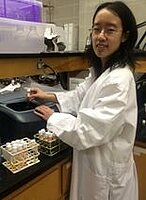Evaluation of Bioavailable Dissolved Organic Nitrogen Using Various Algal Species

Jingyi Sun obtained B.S degree in Water and Wastewater Engineering from Beijing University of Civil Engineering and Architecture, Beijing, China in June 2013. During B.S. education, she was an exchange student in Civil Engineering Department at NDSU from August 2012 to May 2013. From August 2013, she became an M.S. student in Agricultural & Biosystems Engineering at NDSU. Her research focus is to evaluate bioavailability of dissolved organic nitrogen using various types of algae for samples obtained from two different wastewater treatment plants (WWTPs) and animal feedlots.
Email: Jingyi.sun@my.ndsu.edu
Phone: 701-541-7053
Fellow: Jingyi Sun
Advisor: Halis Simsek, Ph.D., Assistant Professor Department of Agricultural and Biosystems Engineering, North Dakota State University, Fargo, ND
Evaluation of Bioavailable Dissolved Organic Nitrogen Using Various Algal Species
Dissolved organic nitrogen (DON) from final effluent of WWTPs and animal feedlots from agricultural areas are important nutrient sources for bacterial and algal communities in surface waters such as rivers, lakes, and estuaries. Excess amount of DON in surface waters can cause excess algal growth and dissolved oxygen depletion and ultimately cause eutrophication in water ecosystem. Bioavailable DON (ABDON) is a fraction of DON that is directly or indirectly available as a nitrogen source for algal species through hydrolysis process. ABDON is calculated as the differences of DON initial and DON final during the incubation period. This research will provide the data that both plants may expand their effluent qualities by reducing DON and TDN and may reduce the treatment cost by using algae in the WWTPs. Algal usage in WWTPs will provide a basis for protecting aquatic ecosystems from cultural eutrophication.
Project Objectives:
The main scope of this study is to collect DON and ABDON data from three locations of two different WWTPs and two locations from animal feedlots in order to achieve the following objective:
- To investigate DON and ABDON for four different algae species in a two-stage trickling filter and an activated sludge WWTPs, and in an animal feedlots.
- To examine mixed culture algae and algae + bacteria interactions for 4 different algal species to determine the best algal species to utilize ABDON.
Progress:
Two sets of experiments determining ABDON using algae Chlamydomonas reinhardtii, and Chlorella vulgaris has been completed with different stages of wastewater from Fargo WWTP. Algae will be used in animal wastewater samples from feedlot to evaluate the ABDON under high nutrient conditions.
Significance:
This research will provide important outcomes to improve the quality of surface waters (rivers, lakes. etc.) in North Dakota by minimizing the nutrient entrance to water ecosystem either from WWTPs or from animal feedlots. Using algae to treat the wastewater is a natural and cost effective way. For the first time, different algal species will be used to examine the bioavailability of dissolved organic nitrogen in a two-stage trickling filter WWTP. Determining the best treatment condition for per pure-cultured and/or mixed cultured algae will help us to understand nutrient removal potential of algae very well.

Halis Simsek
AES Ag & Biosystems Eng
Office: ABEN 2016
Phone: 701-231-6107
Email: halis.simsek@ndsu.edu


